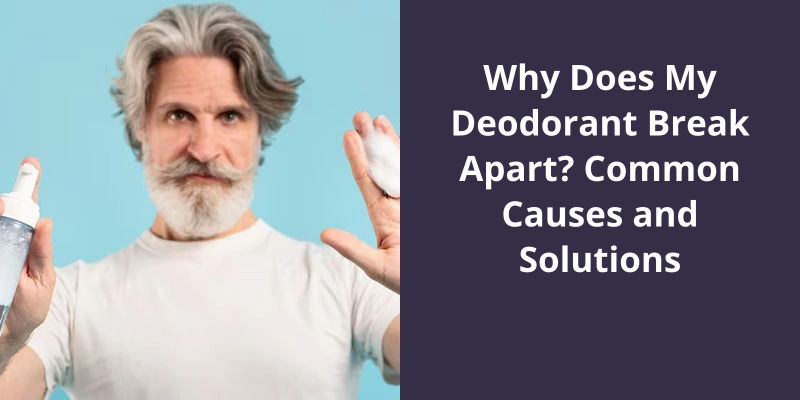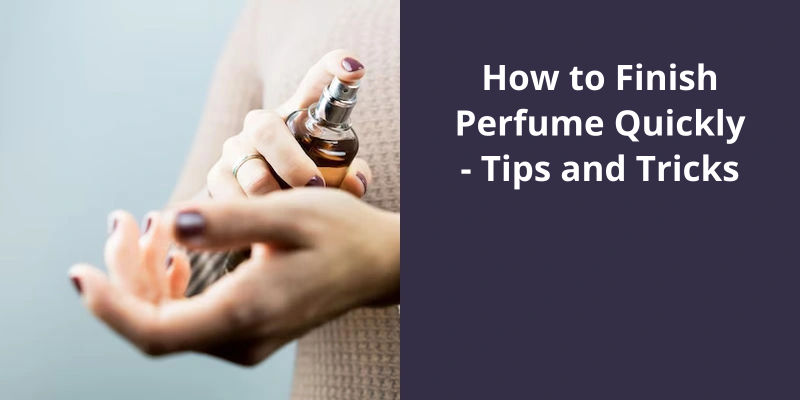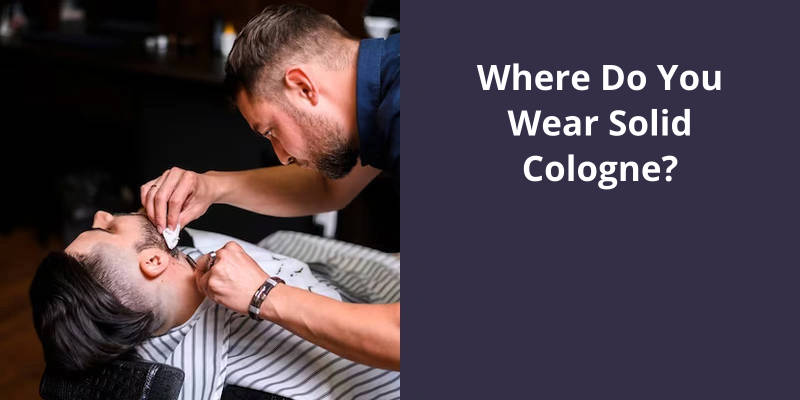Your deodorant may break apart due to several reasons. If it’s stored in hot temperatures, the composition of the deodorant can alter, causing it to become soft or crumbly. Even changes in humidity can make the deodorant stick break. Over-twisting can also break the stick apart because it puts undue pressure on the roll of the deodorant. The quality of the product also plays a role as sometimes, cheaper versions of deodorants can lack the cohesive properties to maintain their structure over time. Lastly, even rough usage or mishandling the product can lead to it breaking apart. Be sure to store your deodorant in cool, dry locations and handle it with care to prolong its lifespan.

How Do You Prevent Deodorant Clumps?
Are you tired of dealing with annoying deodorant clumps? It can be a frustrating experience when youre trying to get ready in the morning and your deodorant just won’t cooperate. Luckily, there are several things you can do to prevent this problem from happening in the first place.
First and foremost, it’s important to choose the right type of deodorant for your needs. If you don’t have any special requirements, a regular stick deodorant is probably your best bet. However, if you’ve sensitive skin or are prone to sweating heavily, you might want to opt for a different type of product, such as a roll-on or spray.
In general, you want to use just enough to cover your underarms, but not so much that it starts to clump or feel sticky. If youre having trouble getting the right amount, try experimenting with different application techniques, such as swiping the stick up and down or using small circular motions.
Many deodorants contain a small amount of powder to help absorb moisture, but if theres too much, it can start to clump up and create a mess. To avoid this problem, make sure youre using the right type of deodorant for your skin type and that youre applying it correctly.
There are plenty of natural deodorants on the market that don’t contain any harsh chemicals or irritating ingredients, and many of them are designed to work just as well as traditional products. Consider trying one of these options to see if it helps.
Aside from following the aforementioned tips to prevent deodorant residue, there are a few other things you can do to reduce build-up and stains on clothing. Read on to learn more.
How Do You Prevent Deodorant Residue?
Deodorant residue is a common problem that can leave unsightly stains on clothing and be difficult to remove. Fortunately, there are several steps you can take to prevent deodorant buildup and stains. One of the most important is to apply deodorant to dry underarms before getting dressed. This helps the product to be absorbed into the skin rather than getting trapped in clothing fibers.
If youre looking for an alternative to traditional white stick deodorants, there are several options to consider. For example, you may want to try a clear gel deodorant or a natural deodorant that’s formulated with ingredients like baking soda and essential oils. These products are less likely to leave residue on clothing and can be more gentle on skin.
To further reduce deodorant buildup and stains, consider using a gentle fabric softener when washing your clothes. This can help to break down any residue that may have accumulated on the fibers, making it easier to wash away. Additionally, it’s important to avoid using hot water when washing clothes that may have deodorant stains, as this can set the stains and make them more difficult to remove.
They’ll have the tools and expertise needed to remove even the toughest stains, ensuring that your clothes look and feel their best.
Different Types of Deodorants (Sprays, Roll-Ons, Etc.) and Their Pros and Cons in Terms of Preventing Residue
This topic explores the various types of deodorants available, including sprays, roll-ons, and others, and their effectiveness in preventing residue. By understanding the pros and cons of each type, consumers can make informed decisions about which deodorant they choose to use.
If you’ve been experiencing any of these issues, it’s possible that you’re using the wrong deodorant. From rashes to persistent odor, there are several signs that can indicate it’s time to switch up your underarm routine. In this article, we’ll explore some of the key indicators that you might be using the wrong deodorant, as well as some tips for finding the right one for your needs. But before we dive in, here’s one simple piece of advice: consider applying your deodorant at night instead of in the morning.
How Do You Know if You’re Using the Wrong Deodorant?
Deodorant is a personal care product that most people use without giving it much thought. However, when it comes to choosing the right deodorant, not all products are created equal. In fact, many people unknowingly use the wrong deodorant. So, how do you know if youre using the wrong one?
Firstly, having a rash around your armpits could be a sign that youre using the wrong type of deodorant. Those little red bumps indicate that you may be having an allergic reaction to your product. It’s important to switch to a hypoallergenic formula to relieve inflammation and reduce the chance of it happening again.
Secondly, if your shirts have underarm stains and a distinct odor even after washing them, it’s a red flag that youre using the wrong type of deodorant. These stains are caused by a bacteria build-up, and some deodorants can exacerbate the problem. It’s important to switch to an antiperspirant that controls sweat and kills bacteria.
Thirdly, if you find yourself reapplying your deodorant more than twice a day, it may be time to switch products. A good deodorant should keep you feeling fresh and clean for up to 24 hours. If you find you need to reapply multiple times, you may be using the wrong formula for your body chemistry.
Our bodies change over time, and what may have worked a year ago might not be effective anymore. It’s essential to switch to a new product to avoid smell and stains.
Finally, a bonus tip: don’t put deodorant on in the morning. Apply it at night before bed. When applied at night, it can penetrate the sweat glands and block sweat and odor effectively. When applied in the morning, it may not work as efficiently as during the day, which could make it ineffective.
The Potential Health Risks Associated With Certain Ingredients Commonly Found in Deodorants
- Aluminum compounds
- Parabens
- Triclosan
- Talc
- Silica
- Fragrances
- Propylene glycol
- Phthalates
- Formaldehyde
- Alcohol
Source: 5 Signs You’re Using the Wrong Deodorant – Men’s Journal
Now that we know the cause and solution for deodorant pilling, let’s dive into some other common deodorant problems and their fixes.
Why Is My Deodorant Pilling?
However, it’s not just about the amount of deodorant applied, but also the type of fabric you wear. Certain fabrics like polyester and nylon tend to rub against the skin and cause friction, leading to the deodorant pilling. To avoid this, consider wearing fabrics that have a smoother texture like cotton or silk.
Another reason why deodorant may be pilling is because of the products formulation. Some deodorants contain ingredients that are prone to pilling, such as aluminum and talc. It’s important to read the labels and check for any ingredients that could be causing the issue.
Additionally, skin type can play a role in deodorant pilling. People with dry skin may find that their deodorant pills more often. It’s also important to wait a few minutes after applying moisturizer before applying deodorant to allow it to fully absorb.
Pay attention to the amount and type of deodorant you use, the fabrics you wear, and your skin type. With a few adjustments, you can say goodbye to deodorant pilling for good.
Different Types of Deodorants and Their Ingredients
- Alcohol-free deodorants:
- Propylene glycol
- Glycerin
- Water
- Antiperspirant deodorants:
- Aluminum chlorohydrate
- Aluminum zirconium trichlorohydrex glycine
- Aluminum chloride
- Natural deodorants:
- Baking soda
- Cornstarch
- Essential oils
- Clinical strength deodorants:
- Aluminum zirconium tetrachlorohydrex gly
- Aluminum sesquichlorohydrate
- Crystal deodorants:
- Potassium alum
- Ammonium alum
It’s frustrating when your deodorant suddenly becomes grainy and difficult to use. But don’t worry, there’s a simple explanation for this phenomenon. Read on to learn more about why your deodorant may crystallize and how to prevent it from happening in the future.
Why Does My Deodorant Crystallize?
Other factors that can contribute to deodorant crystallizing include temperature changes and exposure to air. In some cases, ingredients in the deodorant may not be compatible and can cause separation and crystallization.
To prevent deodorant crystallization, it’s important to store it in a cool, dry place and to avoid leaving it in hot environments such as inside a car on a sunny day. It’s also helpful to shake or stir the deodorant before use to prevent separation of ingredients. If the deodorant has already crystallized, it can be gently heated and stirred to restore it’s smooth texture.
Deodorant crystallization is a common occurrence that happens when shea butter in the deodorant melts and cools too slowly. Temperature changes and exposure to air can also contribute to this issue.
Why Do Some Deodorants Leave Stains on Clothes?
Some deodorants contain ingredients that react with sweat and natural oils on the skin, leading to staining on clothes. The staining may also be a result of the deodorant buildup on the underarms. Using too much deodorant or applying it too soon before wearing clothes can also contribute to staining.
Conclusion
In conclusion, the structural integrity of deodorant can be compromised due to the natural loss of moisture over time. While this may be frustrating for those who find themselves with a broken stick, it’s important to recognize that this is a normal occurrence. Understanding the underlying cause of deodorant breakage can help to inform the way we store and use our personal care products, ultimately prolonging their lifespan and optimizing their effectiveness. As with any consumer goods, it’s important to consider the quality and composition of the products we use and make informed decisions based on our personal needs and preferences.





